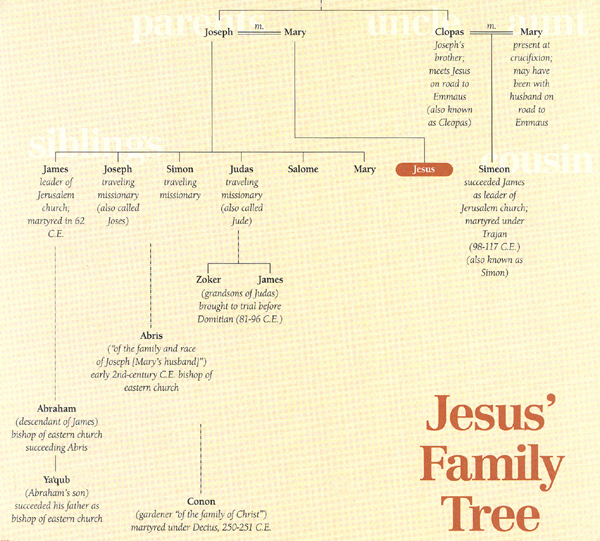
Teaching at the synagogue in Nazareth, Jesus amazes his fellow congregants. “Is not this the carpenter’s son? Is not his mother called Mary?” his astonished listeners ask. “And are not his brothers James and Joseph and Simon and Judas? And are not all his sisters with us?” (Matthew 13:55–56). The story of Mary and Joseph is, of course, known by everyone. But who are these brothers and sisters of Jesus?
Throughout the New Testament and other early Christian literature, we find references—often mere hints—to Jesus’ siblings and cousins. How reliable are these obscure accounts? How much can they tell us about Jesus’ extended family?
Various traditions, as we shall see, have understood these siblings differently: as half siblings, as step siblings or as more distant relatives. But little has been said about the role these people once played in the early Church. By reading the New Testament and early Christian literature closely, however, we can begin to piece together a portrait of some of Jesus’ closest relatives. Their story, as we shall see, is not just a family history, but an account of the earliest days of the Christian Church, which Jesus’ family helped develop—both within Palestine and perhaps also further afield. Ancient sources allow us to trace the family’s continued leadership among Jewish Christians until at least the early second century.
Matthew and Mark both list four brothers of Jesus, with slight variations: Matthew 13:55 names “James and Joseph and Simon and Judas,” whereas Mark 6:3 gives “James and Joses and Judas and Simon.” Assuming the brothers are listed in age order, James is the oldest. Joseph comes next. (The name Joses, which Mark gives to the second brother, was a common abbreviation for Joseph. No doubt Joses was called this to distinguish him from his father.) Since Matthew and Mark differ in the order in which they list Simon and Judas, we cannot be sure who was younger. (In English usage, Judas has been conventionally known as Jude; this form of the name usually appears on the New Testament letter attributed to this brother of Jesus.)
The New Testament does not tell us the names of Jesus’ sisters, nor does it mention how many there were. We only know it was more than one, since Matthew refers to “all his sisters,” and “all” in Greek refers to two or more. (Mark 6:3 simply mentions “his sisters.”) Later Christian literature gives the names Mary and Salome to Jesus’ sisters.1 These names were extremely common among Jewish women in Palestine, but Salome seems not to have been used outside Palestine, in the Jewish Diaspora. This suggests that the tradition of these two names goes back to Palestinian Jewish-Christian tradition, and so may be historically reliable.
Jesus’ brothers were evidently known as “the brothers of the Lord” in early Christian circles. This is how Paul describes them in 1 Corinthians 9:5 and Galatians 1:19.
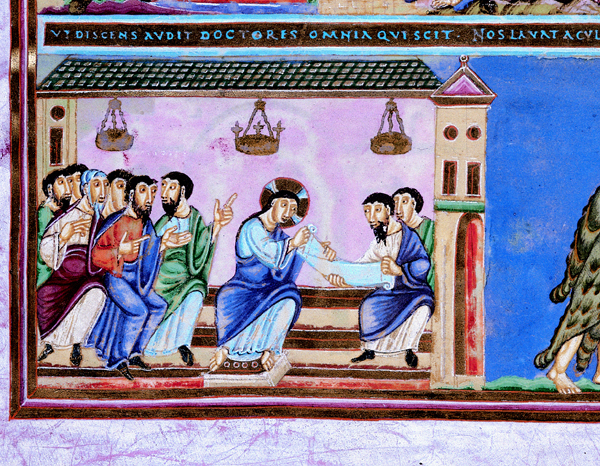
It is clear that the New Testament references to the brothers of Jesus are describing a family relationship. But “brother” need not refer to a full blood brother. Half brother, stepbrother or even more distant family relationships are possible meanings. Whether these scriptural passages are references to blood relatives has been much debated since at least the fourth century, mainly because of the implications for the traditional doctrine of the perpetual virginity of Mary. Exegetes have taken three major stances:
(1) Most modern exegetes, including some Roman Catholic scholars, hold that the brothers and sisters were the children of Joseph and Mary, born after Jesus.2 This is often referred to as the Helvidian view, named for a fourth-century Roman who defended this position. His work is known only through Jerome’s exposition—and refutation—of it.
(2) The traditional view of the eastern Orthodox churches is that the brothers and sisters were children of Joseph by a previous marriage and were therefore older than Jesus. This is sometimes called the Epiphanian position, after its supporter Epiphanius, the fourth-century bishop of Salamis, in Cyprus. The idea that the brothers and sisters of Jesus were children of Joseph by a previous marriage is also found in three second-century Christian works (the Protoevangelium of James, the Infancy Gospel of Thomas and the Gospel of Peter).3
(3) The traditional western Catholic view is that the brothers and sisters were first cousins of Jesus. This is sometimes called the Hieronymian view, after Jerome, the great Christian scholar (d. 420). Although this view still has its supporters, it is the least probable. Its advocates emphasize that the Greek word for brother can be used for blood relationships more distant than siblings. But the earliest Christian literature seems to regard the brothers as siblings. For example, the second-century historian Hegesippus calls James and Jude “brothers of the Lord,” but identifies Simeon the son of Clopas as the “cousin of the Lord,” evidently distinguishing between the two relationships.4
If the third view is improbable, it is not easy to decide between the other two views. But whether Jesus’ brothers and sisters were half siblings or stepbrothers and stepsisters, children of Joseph by a previous marriage, we can be sure that they all belonged to the family household of Joseph and Mary in Nazareth. The gospel traditions regularly refer to Jesus’ brothers in company with his mother (Matthew 12:46–47, 13:55; Mark 3:31–32, 6:3; Luke 8:19–20; John 2:12; Acts 1:14; Gospel of the Nazarenes frag. 2).a
To learn more of Jesus’ collateral relatives, we must turn to the writer Hegesippus, who lived in Palestine in the mid-second century and recorded some local traditions concerning Jesus and his relatives. Except for a few fragments, his work unfortunately has not survived. What we know of his writings comes mostly from quotations by the famous third- to fourth-century Church historian Eusebius. Although the traditions in Hegesippus tend to be legendary, the legends are attached to historical figures who were revered as Christian leaders and martyrs in the memory of the Jewish-Christian communities of Palestine. Though the tales about them might not always ring true, we can be sure that these people did exist and were related to Jesus in the way Hegesippus claims.
According to Hegesippus, Jesus’ putative father, Joseph, had a brother named Clopas.5 The name Clopas is extremely rare. Only two other certain occurrences of it are known, and only one of these is in the New Testament.6 According to John 19:25, three women stood by the cross while the Roman soldiers cast lots for Jesus’ clothes: Jesus’ mother Mary, Mary Magdalene and a woman named “Mary of Clopas.”b Clopas is not a place-name but rather the name of this Mary’s husband; the phrase could be worded “Mary belonging to Clopas.” Since Clopas is such a rare name, it probably refers to Joseph’s brother, Jesus’ uncle, as referred to by Hegesippus. Apparently an aunt of Jesus, as well as his mother, were among those Galilean women who accompanied him on his last journey to Jerusalem and witnessed the crucifixion.
According to the Gospel of Luke, after the discovery of the empty tomb on the first Easter, two of Jesus’ disciples walked to Emmaus, a village about 7 miles north of Jerusalem. On the way, Jesus appeared to them. One of the two is identified as Cleopas (Luke 24:18). This Greek name is not the same name as the Semitic name Clopas, but it was common for Palestinian Jews at this period to be known by both a Semitic name and a similar sounding Greek name. Thus, for example, the Greek name Simon was very commonly used as the equivalent of the Hebrew Simeon, and either name could be used for the same individual. It is quite possible that Joseph’s brother Clopas also used the Greek name Cleopas and that he was in Jerusalem with his wife at the time of the crucifixion. If so, it is probably this brother of Joseph that Luke is referring to. His unnamed companion may have been his wife, Mary.
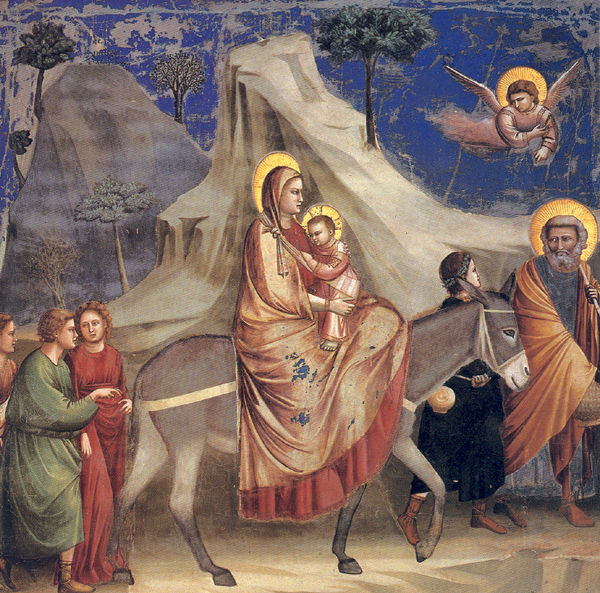
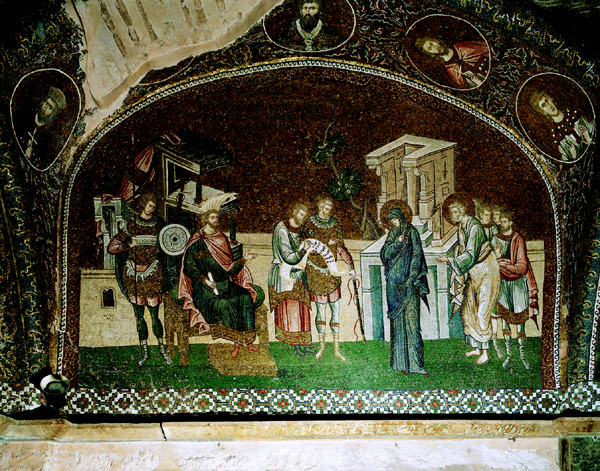
What happened to Jesus’ brothers after the crucifixion? Apparently the brothers, who the Gospels indicate were less than enthusiastic about Jesus’ activity at earlier points in his ministry (Matthew 13:57; Mark 3:21, 31, 6:4; John 7:5), had come round by the time of his death. They soon became prominent leaders of the early Christian movement.
We know the most about James, who became the leader of the Jerusalem Church. Paul tells us that three years after his own conversion, he went to Jerusalem and visited “James the Lord’s brother” (Galatians 1:19), indicating that he was then already someone of significance in the Jerusalem Church. Later James rose to a position of unique preeminence in the Jerusalem Church (Acts 15:13, 21:18). Peter had left the city (Acts 12:17), and the Twelve had dispersed, and thus no longer formed the Christian leadership in Jerusalem. Apparently, James filled the vacuum.
Later writers called James “bishop” of Jerusalem. The term is anachronistic here, but the title nevertheless fairly accurately describes James’s role.
James’s influence was by no means confined to Jerusalem, however. The Jerusalem Church was the mother church of all churches, and as such was naturally accorded the same kind of central authority over the Christian movement that Jerusalem and the Temple had long had for the Jewish people. As head of the Jerusalem Church, James occupied a position of unrivaled importance in the early Christian movement. One small indication of this is the fact that although the name James was extremely common, this James could be identified simply by his name with no need for further explanation (1 Corinthians 15:7; Galatians 2:12; Acts 12:17, 15:13, 21:18; James 1:1; Jude 1). Further, he bears the distinction of being the only Christian mentioned by name in a first-century source not written by a Christian: The first-century Jewish historian Flavius Josephus records James’s martyrdom in 62 C.E. at the hands of the high priest Ananus II (son of Annas and brother-in-law to Caiaphas). Ananus had him executed by stoning, probably under the law that prescribed this penalty for someone who entices people to apostasy (Deuteronomy 13:6–11).7
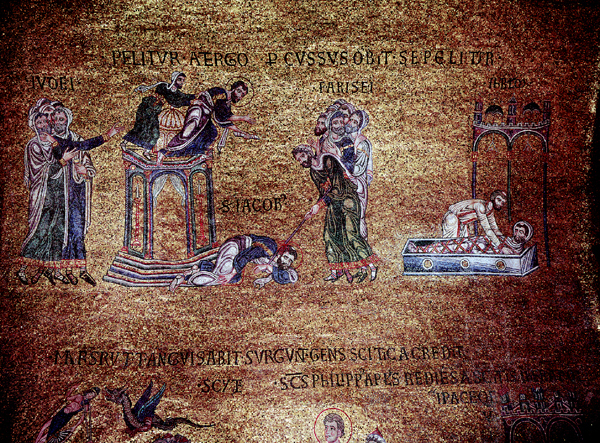
While James assumed preeminent leadership in Jerusalem, at the center of the Christian movement, Jesus’ other brothers appear to have worked as traveling missionaries. In 1 Corinthians 9:5, Paul defends the right of himself and the apostle Barnabas to have their wives accompany them on their missionary journeys and to receive food and hospitality from the Christian communities among whom they worked. After all, Paul writes, the “other apostles and the brothers of the Lord” have that right. Apparently, Jesus’ brothers were so well known as missionaries that they were the obvious examples for Paul to cite, even when speaking to Christians in Corinth. Since it is unlikely that James was well known for his missionary travels, Paul must be referring primarily to the other brothers: Joses (Joseph), Simon and Jude (Judas).
Paul’s passing reference to the brothers reminds us of how very fragmentary our knowledge of the early Christian mission is. But we do have at least one source that corroborates Paul’s view of the family as famous missionaries. According to Julius Africanus, a native of Jerusalem who lived in Emmaus in the early third century, the relatives of Jesus were known as the desposynoi, a term meaning “those who belong to the master [or sovereign;
This little-noticed reference from Julius Africanus provides us with a rare glimpse of Christianity in Galilee and shows us that not only Jerusalem, but also Nazareth and Kokhaba, where other members of the family were based, were significant centers of early Christianity in Jewish Palestine.
One final point that gives us added confidence in the reliability of what Julius Africanus is telling us: The term desposynoi is not found in any other source. Julius even has to explain what it means. It is not a term he would have used had he not found it in his source. It must be the term by which members of the family of Jesus were known in those Palestinian Jewish-Christian circles in which they were revered leaders. Just as it was normal practice in the ancient Near East for members of the royal family to hold high offices in government, so Palestinian Jewish Christians felt it appropriate that Jesus’ brothers, cousins and other relatives should hold positions of authority in his Church. Indeed, the term desposynoi could well have the sense, more or less, of “members of the royal family.” The term suggests that not only “the brothers of the Lord” but also a wider circle of relatives played prominent leadership roles. Jesus’ aunt and uncle, Mary and Clopas, may well have been a husband and wife team of traveling missionaries. And if the names of the sisters of Jesus—Mary and Salome—were correctly preserved in tradition, this would imply that they, too, were well-known figures in the early Church.
Julius Africanus speaks only of the travels of the desposynoi within Palestine, but their mission may well have extended to parts of the Jewish Diaspora. An indication that the family’s influence (especially James’s) extended to the eastern church comes from the apocryphal Gospel of Thomas, which reflects the gospel traditions of Christianity in the north Mesopotamian area perhaps as early as the late first century. The New Testament itself deals almost exclusively with Christianity’s spread westwards from Palestine, but it must have spread just as quickly to the east. For Palestinian Jews, the eastern Diaspora—in Mesopotamia and areas further east (see Acts 2:9)—was just as important as the western Diaspora. In one of the sayings of Jesus found in the Gospel of Thomas (logion 12), Jesus tells his disciples that after he has departed they should “go to James the Righteous, for whose sake heaven and earth came into being.” Though there is no likelihood that this is an authentic saying of Jesus, it nevertheless reflects the authority attributed to James in north Mesopotamian Christianity, where this text originated, during his own lifetime.
Further evidence of the influence of Jesus’ family in the east comes from a medieval chronicle that lists the early bishops of Ctesiphon-Seleucia, a metropolitan center on the Tigris River, in central Mesopotamia. Following the name of the first-century founder of the church, the next three bishops are Abris, who is said to have been “of the family and race of Joseph [the husband of Mary]”; Abraham, “of the kin of James called the brother of the Lord”; and Ya‘qub, Abraham’s son. While it may seem hazardous to trust such a late source, the medieval chroniclers had access to dependable older sources. Further, claims to descent from the family of Jesus are rare in Christian literature, suggesting that when such a claim is made it should be regarded as credible. Later Christian writers were not in the least prone to inventing legendary descendants of this family or to ascribing such descent to historical persons without warrant. It seems to be a reasonable possibility that members of Jesus’ family traveled to the eastern Diaspora, where their descendants became important Christian leaders in the second century.
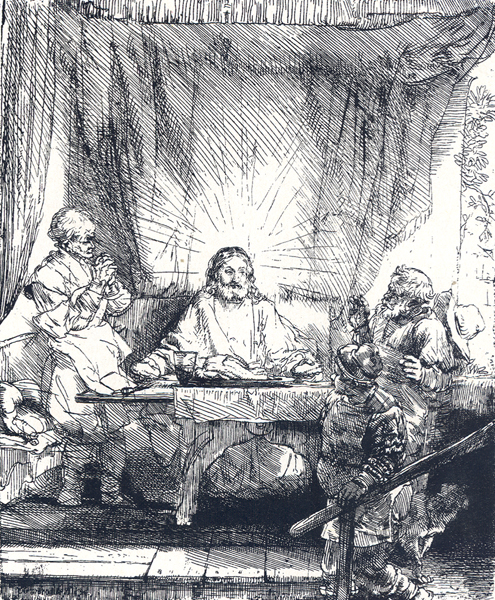
The leadership role played by Jesus’ relatives passed from one family member to another and from one generation to the next. Following James’s martyrdom, Simeon, the son of Clopas and Mary, succeeded his first cousin as “bishop of Jerusalem.” As the leader of the Jerusalem Church, Simeon (or Simon, both the Hebrew and Greek versions of the name are found) was doubtless the most important figure in Jewish Christianity for at least 40 years—until he, too, was martyred, during the reign of Trajan (98–117 C.E.).10 When Luke’s first readers read of Cleopas (Luke 24:18) and John’s first readers saw the name Mary of Clopas (John 19:25), many of them would no doubt have recognized the parents of their famous contemporary, Simeon.

According to Hegesippus, Simeon was crucified by the Romans for political subversion because he was of a Davidic family and supported the alleged Davidic king, Jesus. While there is much that is legendary in Hegesippus’s hagiographical account of Simeon’s martyrdom (especially about his torture), the basic facts seem to be historically reliable. They fit well into the period between the two great Jewish revolts (the First Jewish Revolt ended with the Roman destruction of the Jerusalem Temple in 70 C.E.; the second lasted from 132 to 135 C.E.), a time when the Roman authorities in Palestine were highly sensitive to the dangers of Jewish political nationalism.
Hegesippus’s hagiographical account of the death demonstrates the great reverence with which Simeon was remembered in the years immediately following his death: Simeon, we are told, “bore witness through tortures of many days’ duration, so that all, including the governor, marveled exceedingly how an old man of a hundred and twenty years could thus endure.” One hundred and twenty years is the biblical limit on human life (Genesis 6:3), which no one after Moses may exceed (Deuteronomy 34:7), but which someone as righteous as Moses might equal.
Hegesippus’s account traces the work of Jesus’ family into a third generation. The historian relates that, in the late first century, two grandsons of Jesus’ brother Jude, called Zoker and James, came under suspicion of the Roman authorities because they were descendants of David.11 According to Hegesippus, the brothers were brought before the emperor Domitian for trial:
There still survived of the family of the Lord the grandsons of Jude, his brother after the flesh, as he was called. These they informed against, as being of the family of David; and the ‘evocatus’ brought them before Domitian Caesar. For he feared the coming of the Christ, as did also Herod. And he asked them if they were of David’s line, and they acknowledged it. Then he asked them what possessions they had or what fortune they owned. And they said that between the two of them they had only nine thousand denarii, half belonging to each of them; and this they asserted they had not as money, but only in thirty-nine plethra of land, so valued, from which by their own labor they both paid the taxes and supported themselves.
To prove that they were hardworking peasant farmers, these nephews of Jesus displayed their tough bodies and the hardened skin of their hands. They also explained that the kingdom of Christ was not an earthly one (and so, Hegesippus implies, not a kingdom whose supporters would rebel against the empire) but one that would come at the end of history. Having been convinced that they were harmless and despising them as mere peasants, Domitian released them and ordered the persecution of Christians to cease.
While the account of the trial is historically improbable and has a strong apologetic thrust (it tries to show that Jewish Christianity is not a politically dangerous movement), it is at least a legend about real historical persons.12
With this legend, however, our trail ends. After the brothers Zoker and James, the family of Jesus fades into obscurity.13
Or does it?
Today, visitors to Nazareth are ushered through a damp cave beneath the Church of the Annunciation. The cave, they are told, was dedicated in ancient times to the cult of a local martyr named Conon, who died far from his home during the persecution of Christians under Emperor Decius in 250–251 C.E. According to the account of his martyrdom, Conon was employed as a gardener on the imperial estate at Magydos, in Pamphylia, Asia Minor. When court authorities questioned Conon as to his place of origin and ancestry, he replied: “I am of the city of Nazareth in Galilee, I am of the family of Christ, whose worship I have inherited from my ancestors.”
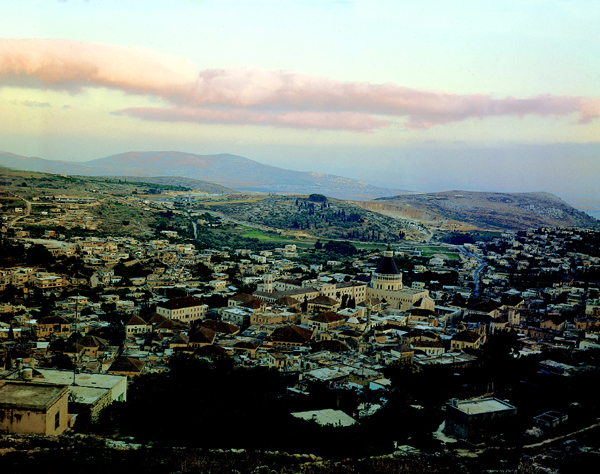
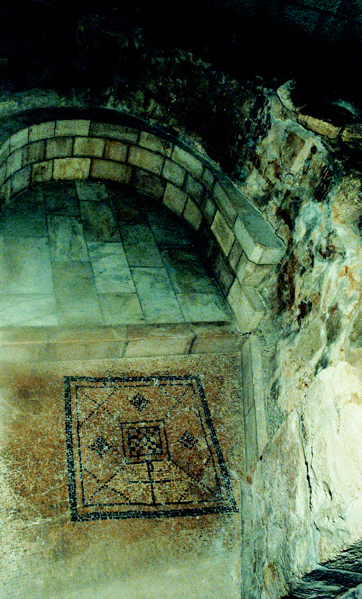

Is this simply a metaphorical reference to Conon’s spiritual origins as a Christian? Perhaps—but such claims are extremely rare. It is far more likely that this is a literal claim of descent from the family of Jesus. As such, it is the last we find in the early Christian literature. After Conon, Jesus’ family disappears from the record.14
MLA Citation
Footnotes
The Gospel of the Nazarenes is an early Jewish-Christian gospel, now known only in a few quotations in works by ancient Christian writers.
The list in John 19:25 reads as follows: “[Jesus’] mother and his mother’s sister, Mary of Clopas, and Mary Magdalene.” This could be read as a list of four women. Most likely, however, there are only three. “Mary of Clopas” is probably in apposition to “his mother’s sister.” If Mary of Clopas was Clopas’s wife, then she was in fact Jesus’ mother’s husband’s brother’s wife—a relationship that, not surprisingly, the evangelist has preferred to state less precisely as his mother’s sister.
We know of this event only from Julius Africanus, who says that Herod attempted to obscure his own non-Jewish origins by destroying the record of others’ Jewish descent.
Endnotes
Protoevangelium of James 19:3–20:4; Gospel of Philip 59:6–11; Epiphanius, Panarion 78.8.1; 78.9.6.
For a recent argument, by a Roman Catholic New Testament scholar, that this is the most probable implication of the New Testament evidence, see John P. Meier, A Marginal Jew: Rethinking the Historical Jesus, 2 vols. (New York: Doubleday, 1991–1994), vol. 1, pp. 316–332, and “The Brothers and Sisters of Jesus in Ecumenical Perspective,” Catholic Biblical Quarterly 54 (1992), pp. 1–28. For a critique of Meier’s arguments, see Richard Bauckham, “The Brothers and Sisters of Jesus: An Epiphanian Response to John P. Meier,” Catholic Biblical Quarterly 56 (1994), pp. 686–700.
Protoevangelium of James 9:2, 17:1–2, 18:1; Infancy Gospel of Thomas 16:1–2; Gospel of Peter, according to Origen, Commentary on Matthew 10.17.
The other is an Aramaic document from the early second century C.E., found at Murabba‘at (Mur. 33, line 5).
Josephus, Antiquities of the Jews 20.9.1. The more legendary account in Hegesippus agrees that he suffered death by stoning.
In my Jude and the Relatives of Jesus in the Early Church (Edinburgh: T & T Clark, 1990), chap. 7, I argue in detail that the Lukan genealogy of Jesus derives from the circle of the brothers of Jesus, who adapted a traditional family genealogy to make it the vehicle of a quite sophisticated christological message.
According to E.M. Smallwood (“Atticus, Legate of Judaea Under Trajan,” Journal of Roman Studies 52 [1962], pp. 131–133), the martyrdom may be more firmly dated to either between 99 and 103 C.E. or between 108 and 117 C.E.
Quoted in Eusebius, Hist. Eccl. 3.19.1–3.20.7; 3.32.5–6. The brothers’ names are preserved not in Eusebius’s quotations from Hegesippus but in another ancient summary of Hegesippus’s account of them (Paris MS 1555A and Bodleian MS Barocc. 142).
Apart from the information that members of the third generation of the family of Jesus were still active in Christian leadership, the most interesting aspect of the story is what it tells us about the farm that the brothers held in partnership. The size and value given are so precise that it is likely that they rest on accurate detail. The farm was not divided between the brothers but owned jointly, no doubt because this family continued the old Jewish tradition of keeping a small holding undivided as the joint property of the “father’s house,” rather than dividing it between heirs. So, two generations back, this farm would have belonged to Joseph and his brother Clopas. Unfortunately, since the plethron has two possible sizes, it seems impossible to determine whether the farm was about 12 or 24 acres. In either case, this is not much land to support two families, and Joseph had at least seven children to feed. It is not surprising that he (and later Jesus) supplemented the family income by working as a carpenter.
The Franciscan excavators discovered a fourth-century mosaic bearing the inscription “Gift of Conon, deacon of Jerusalem” at the entrance to the cave beneath the Church of the Annunciation. They speculated that the cave was dedicated to the local cult of Conon, the martyred gardener, and that a later gentile Christian from Jerusalem dedicated the mosaic out of reverence for his namesake, who was honored there.
Readers wishing to study the relatives of Jesus more fully can turn to my longer studies: Relatives of Jesus, esp. chaps. 1–2; “Salome the Sister of Jesus, Salome the Disciple of Jesus, and the Secret Gospel of Mark,” Novum Testamentum 33 (1991), pp. 246–254; “Mary of Clopas (John 19:25),” in G.J. Brooke, ed., Women in the Biblical Tradition (Lewiston, NY: Mellen, 1992), pp. 231–255; “James and the Jerusalem Church,” in Bauckham, ed., The Book of Acts in Its Palestinian Setting.


